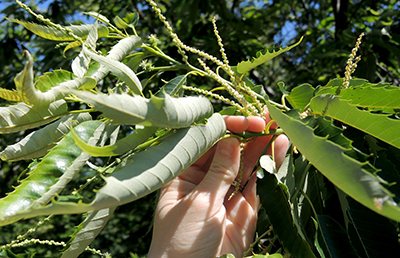Potato leafhopper arrives early in chestnuts
Potato leafhopper has arrived in Michigan, carried north on warm air and storms from the southern states.

Potato leafhopper has been confirmed throughout the Lower Peninsula and growers should be scouting carefully as leaves expand. Like many plants, chestnuts are sensitive to the saliva of potato leafhoppers that is injected while feeding. Damage to leaf tissue can cause reduced photosynthesis, which can impact production, affect nut quality and damage the tree. Growers with young trees with limited leaf area should be particularly vigilant in scouting for and suppressing potato leafhopper.
Scouting should be performed weekly, following storm systems originating in the south, or after neighboring crops like alfalfa are harvested. Growers can walk through orchards, disturbing branches and watching for the flush of activity when leafhoppers take flight. To confirm their presence, flip the shoots or leaves over and look for adults and nymphs on the underside of leaves. Pay special attention to succulent new leaves on the terminals of branches. Growers may also hang yellow sticky traps in the orchard to catch potato leafhopper. Be sure to hang traps on both the edge and interior of the block.

Leaf cupping caused by leafhopper feeding on chestnut. Photo by Erin Lizotte.
For more information on how to identify potato leafhopper and symptoms of damage, as well as management recommendations, please refer to the pest management section of the Michigan State University Extension Chestnuts webpage. For a list of currently registered insecticides, download a copy of the “Michigan Chestnut Management Guide 2017.”
Please continue to visit the MSU Extension Chestnuts webpage and the MSU Chestnut News Facebook page for up-to-date information. Also, be sure to sign up for MSU Extension’s Fruit & Nuts Production newsletter.
This material is based upon work supported by the National Institute of Food and Agriculture, U.S. Department of Agriculture, under Agreement No. 2015-09785. Any opinions, findings, conclusions, or recommendations expressed in this publication are those of the author(s) and do not necessarily reflect the view of the U.S. Department of Agriculture.



 Print
Print Email
Email

